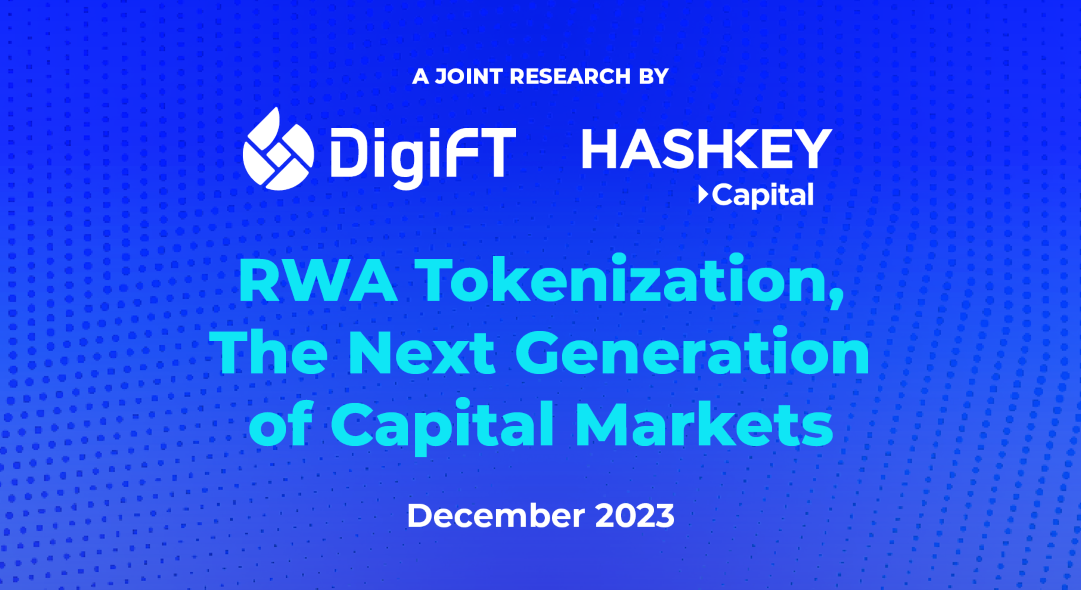“Real World Assets Tokenization, The Next Generation of Capital Markets”
Download The Full Report Here (EN) - PDF
“真实世界资产(RWA)代币化引领下一代资本市场”
下载完整报告(中文) - PDF
Introduction
This 46-page report, titled “RWA Tokenization: The Next Generation of Capital Markets,” delves into the evolving landscape of tokenized Real-World Assets (RWAs). It explores the dynamics, models, regulatory intricacies, and growing investor interest in this domain.
Our research highlights the burgeoning potential of RWA tokenization within capital markets, despite its current nascent stage. RWA tokenization has garnered significant attention from leading financial institutions, particularly in the tokenization of government bonds and other capital market products via blockchain technology. A striking finding is the dramatic increase in Total Value Locked (TVL) in tokenized RWA, primarily in US Treasury Bill-related products, which surged approximately 600% from USD 100 million at the start of 2023 to a remarkable USD 784 million presently. This trend underscores a keen interest in stable yields, driving the demand for tokenized RWA in short-term treasury management and collateral diversification.
Key Takeaways
- Limited market size but big potential: The current market size of Real World Assets (RWA) is small compared to traditional financial markets. The potential market cap of RWA could potentially reach tens of trillions of dollars in the next five years, driven by efficiency and cost advantage of blockchain technologies.
- Supply side - Fixed income products dominance, the rise of US Treasury bill-related products and the fall of private credit products: According to data from RWA.xyz and Dune.com, the Total Value Locked (TVL) for major RWAs is concentrated in US treasury bill-related products. It has grown rapidly from $100 million at the beginning of 2023 to the current total value of 784 million during the crypto winter. The TVL in private credit products has declined from its peak of $1.5 billion in mid-2022 to just $500 million currently, mainly due to the collapse of FTX, 3AC and Luna-UST.
- Demand side - Institution dominance, mainly for short-term treasury management and asset diversification: By analysing the wallet addresses holding the US treasury bill-related products, we can observe that the primary holders are institutional investors. Currently, the demand for RWAs is mainly concentrated on the short-term treasury management needs for crypto companies or DAOs. Besides, DeFi protocols, such as stablecoin protocols and lending protocols, introduce RWAs to achieve collateral diversification and reduce the overall system risk.
- RWA regulation complexity: RWA encounters diverse regulatory landscapes worldwide. The US enforces strict laws with global reach. In contrast, Switzerland, Singapore, and Hong Kong SAR are showing active support, giving more friendly regulation environment for asset tokenization.
- Innovative models unlock RWA access in DeFi: Using innovative business models such as lending and token wrapping enables RWA integration into DeFi. But challenges such as AML compliance, sales restrictions, and unresolved asset ownership issues are still not addressed. The adoption of RWA will lead to a more regulatory-compliant way of DeFi.
- Outlook: In the short to medium term, the RWA market will be primarily dominated by fixed-income products due to the lack of stable income products in the crypto market, and the demand for risk diversification. In the medium to long term, as the market’s understanding of compliant assets deepens and relevant legal framework becomes more robust, we will see a more diverse range of RWA assets, and potentially we can see the next generation of capital markets powered by token and blockchain technologies.
Authors
Ryan Chen (DigiFT), Henrique Centieiro (HashKey Capital)
With Recommendations From
Annabelle Huang (Amber Group), Joseph Goh (Superscrypt), Sébastien Derivau (Steakhouse Financial), and Aaron Collett (Goldfinch)
“Real World Assets Tokenization, The Next Generation of Capital Markets”
Download The Full Report Here (EN) - PDF
By providing your email address, you agree with DigiFT’s Privacy Notice (https://doc.digift.sg/document/DigiFT_PRIVACY_POLICY.pdf)
简介
这份46页的研究报告名为 “真实世界资产代币化,引领下一代资本市场”,深入探讨了真实世界资产(RWA)代币化及其市场潜力。该研究深度剖析了代币化RWA趋势、RWA 模型和机制、监管架构和投资者偏好。
研究发现,尽管目前RWA代币化市场规模有限,但具有巨大潜力,持续吸引主流金融机构通过区块链探索资本市场产品代币化。RWA代币化的总锁定价值(TVL)从2023年初的1亿美元上涨了约600%,目前达到约7.84亿美元,其中美国国债相关的产品市场占比最大。研究还发现,市场对稳健收益的迫切需求推动了对RWA的积极投资,以实现短期现金管理和抵押品多样化。
摘要
-
有限规模,无限潜力:与传统金融市场相比,目前市值仅数十亿美金的 RWA(Real-World Assets,真实世界资产)的整体市场规模较小。在区块链技术的效率和成本优势的推动下,RWA的潜在市值在未来五年内可能达到数十万亿美元。
-
供给端主流为固定收益产品,国债代币崛起,私人信贷缩水:根据 RWA.xyz和 Dune.com 的数据,当前主要 RWA 的 TVL(Total Value Locked,总锁定价值)集中于美国国债相关产品,自 2023 年初的 1 亿美金增长到目前7.84 亿美金总市值,在加密市场寒冬中仍展现快速增长趋势。私人信贷产品TVL由于 FTX、3AC、Luna 等项目暴雷事件,从 2022 年中最高峰 15 亿美金一路下行到目前仅5 亿美金。
-
需求端主要为机构投资者,用于短期现金管理和投资组合多元化:通过分析国债代币相关钱包地址,我们可以发现主要的持有者为机构投资者。当前RWA的需求主要集中在加密市场投资者的短期现金管理需求。此外,DeFi协议如稳定币协议和借贷协议等,也纷纷引入RWA来实现投资组合多元化,降低整体系统风险。
-
监管仍面临严峻挑战:RWA在全球范围内面临多样化的监管环境。美国实施严格的证券法,并且具有全球影响力。相比之下,瑞士、新加坡和香港特别行政区表现出积极的支持,为 RWA 提供更友好的监管环境。
-
创新模式将RWA与DeFi结合:采用创新的商业模式,如借贷和代币包装,使具有较高投资门槛的 RWA能够整合到DeFi中。但反洗钱合规性、销售限制和未解决的资产所有权问题等挑战仍未得到解决。RWA 和 DeFi 的融合会一定程度上引导 DeFi 走向合规化。
-
展望:中短期看,由于加密市场缺乏稳定收益产品,以及分散风险的需求,RWA市场产品仍将以固定收益产品为主。中长期来看,随着市场对合规资产认识的加深和相关法律框架的完善,我们将看到更多元化的RWA资产,并有可能见证由区块链和代币共同驱动的下一代资本市场。
作者
Ryan Chen (DigiFT), Henrique Centieiro (HashKey Capital)
推荐语自
Annabelle Huang (Amber Group), Joseph Goh (Superscrypt), Sébastien Derivau (Steakhouse Financial), and Aaron Collett (Goldfinch)
“真实世界资产(RWA)代币化引领下一代资本市场”
下载完整报告(中文) - PDF
提供您的电子邮件地址,即表示您同意DigiFT的隐私声明 (https://doc.digift.sg/document/DigiFT_PRIVACY_POLICY.pdf)
